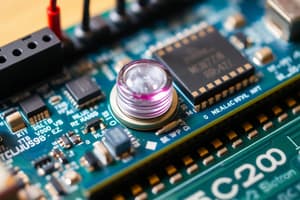Podcast
Questions and Answers
What is the purpose of an analog sensor?
What is the purpose of an analog sensor?
To measure various physical quantities that vary over a range.
Define accuracy in the context of sensors.
Define accuracy in the context of sensors.
Accuracy refers to how closely the sensor indicates the true quantity being measured.
What does resolution refer to in sensor measurements?
What does resolution refer to in sensor measurements?
Resolution is the smallest change that can be observed by the sensor.
Explain the concept of repeatability in sensor technology.
Explain the concept of repeatability in sensor technology.
What does precision refer to when discussing a group of sensors?
What does precision refer to when discussing a group of sensors?
What are the common types of temperature sensors mentioned?
What are the common types of temperature sensors mentioned?
How does a thermocouple work as a temperature sensor?
How does a thermocouple work as a temperature sensor?
Explain the principle behind a Resistance Temperature Device (RTD).
Explain the principle behind a Resistance Temperature Device (RTD).
Describe the behavior of semiconductors with a negative temperature coefficient.
Describe the behavior of semiconductors with a negative temperature coefficient.
What is the purpose of a strain gauge?
What is the purpose of a strain gauge?
How does a linear variable displacement transformer (LVDT) work?
How does a linear variable displacement transformer (LVDT) work?
What is the principle behind a resolver?
What is the principle behind a resolver?
What are some considerations for sensor installation?
What are some considerations for sensor installation?
What are the two common types of analog signals?
What are the two common types of analog signals?
How does a thermistor work?
How does a thermistor work?
What is the purpose of a Hall effect sensor?
What is the purpose of a Hall effect sensor?
What is the advantage of a potentiometer?
What is the advantage of a potentiometer?
Why do strain gauges need to be temperature compensated?
Why do strain gauges need to be temperature compensated?
Flashcards are hidden until you start studying




